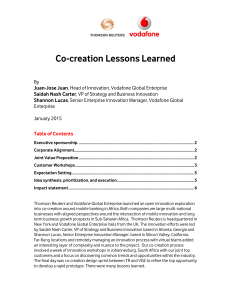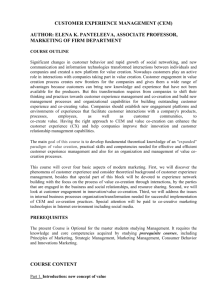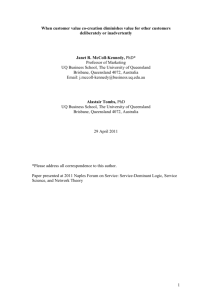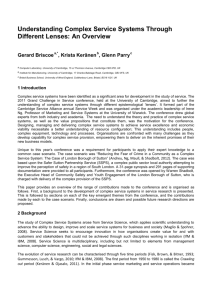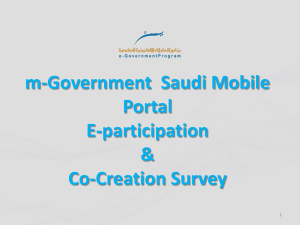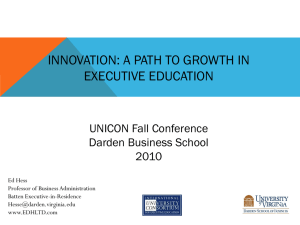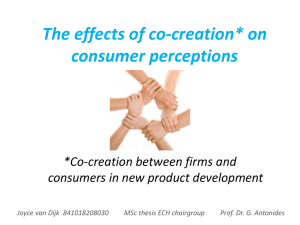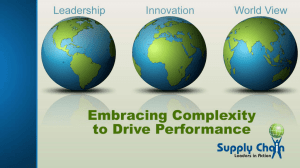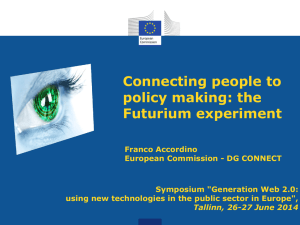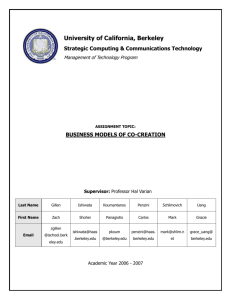Co-creation of value in Innovation
advertisement
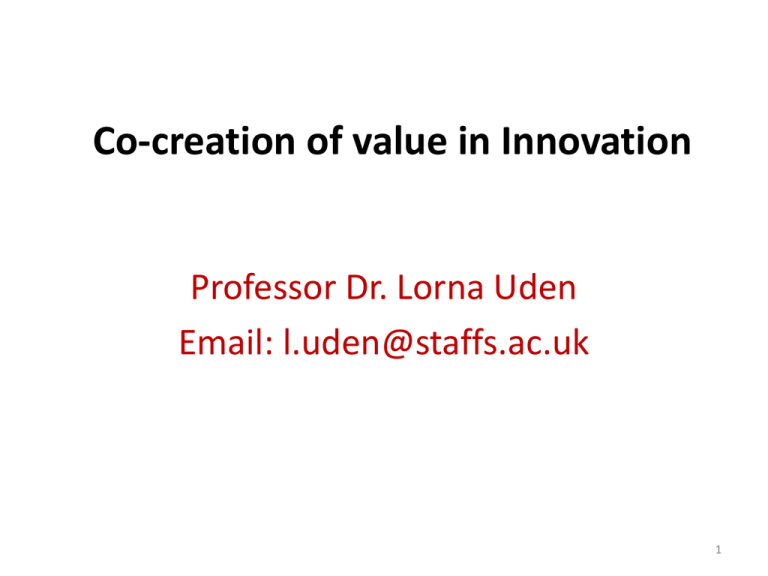
Co-creation of value in Innovation Professor Dr. Lorna Uden Email: l.uden@staffs.ac.uk 1 Introduction • • • • • Overview of Service Innovation Service science or innovation Co Creation of value Conclusion 2 Service Industry • Service sector is the dominant economy in our industrial world. • 80% of jobs are in service sector. • Greater share of large companies’ revenue comes from services. • Service sectors also help improve competitive performance of firms in our modern economies. • Rapid growth of services has vast implications for academics, knowledge creation, education, business practice, and government policy. 3 Service • Services are deeds, processes and performance (Zeithaml et al., 2006). • Service is the application of specialised competences (knowledge and skills) through deeds, processes and performances for the benefit of another entity or the entity itself. (Vargo and Lusch (2006). • Despite the economic domination of services, there is relatively little focus from companies and government on service research and innovation compared to tangible products and technologies (Bitner and Brown, 2007). 4 Service Science • Is a new discipline • Is rooted in the interdisciplinary study of computer science, operations, industrial engineering, mathematics, research business strategy, management sciences, decision theory, social and cognitive sciences and legal sciences. • Aim is to address addressing issues such as to what extent organizations can be restructured, how to manage service innovation, etc. 5 • Goal is to make productivity, quality, sustainability, learning rates and innovation rates more predictable across the service sector. (IBM 2007). • Research in service science seeks to find out how to design, build, operate, use, sustain and dispose of science systems for the benefit of multiple stakeholders such as customers, shareholders, employees, partners and society (IBM 2007). Difference between Invention and Innovation • Invention is a new product. • Innovation is a new value (Szmytkowski, 2005). 7 Innovation • Is a process through which organizations create and transform new knowledge into useful products, services and processes for national and global markets – leading to both value creation for stakeholders and higher standards of living. • Is the mainstay of an organization. • For organizations to remain competitive, innovation is essential. 8 • Is concerned with the process of commercializing or extracting value from ideas. (Rogers 1998). • Is the creation of new knowledge and ideas to facilitate new business outcomes, aimed at improving internal business processes and structures and to create market-driven products and services. (Du Plessis 2007). Innovation (continued) • In today’s economy, businesses need to continuously reinvent themselves in order to adapt to increasingly complex and dynamic market realities. • Organizations including government are under intense pressure to create value. • Innovation is the key for organizations that want to remain competitive. 10 Why Service Innovation? • Service innovations in creating economic growth and wellbeing is increasingly acknowledged (European Commission, 2009). • Service innovation can impact customer-provider interactions and improve the experience of funding, obtaining, installing, maintaining, upgrading and disposing of products.(IfM and IBM 2008). • It can enhance the capabilities of organizations to create value with stakeholders. 11 Service Dominant Logic • Is concerned with value-in-use. • The roles of producers and consumers are not distinct. • Value is always co-created between producers and consumers. • Thus value is co-created through the combined efforts of firms, customers, employees, government agencies, stakeholders and other entities related to any given exchange, but is always determined by the beneficiary (e.g. customer). 12 Co creation of value • In today’s economy, businesses need to continuously reinvent themselves in order to adapt to increasingly complex and dynamic market realities. (Coates 2009). • Standardisation makes it hard for companies to differentiate themselves from competitors. • Today, markets are more fragmented; consumers have unprecedented access to information and networks. 13 • Technologies have created new modes of production and innovation that enable and encourage a greater degree of participation and collaboration. • Aim of co-creation is to enhance organisational knowledge processes by involving the customer in the creation of meaning and value. • Co-creation also transforms the consumer into an active partner for the creation of future value. Organisations today • Must become directly involved with users to ensure positive user experience. • Positive user experiences drive co-created value and mutual benefits for both organisations and users. 15 Experience • Is defined as an intensive individually involved event that is both personally meaningful and fulfilling to the users (Prahalad & Ramaswamy 2004b). • A positive experience leads to user engagement • User experience is divided into two psychological components that influence co creation of value: - Individual involvement - Personal meaning (Gangi & Wasko 2009) 16 Co-production and Co-creation • Co-creation relates to the value received by the customer through usage, consumption or experience. On the other hand, co-production is a component of co-creation relating to specific tasks undertaken by customers that may occur prior to or during usage, consumption or experience (Lusch & Vargo 2006). • Thus, the customer is always co-creator, but not always co-producer. 17 • Co-creation is important because it is: 1. Creative: co-creation is a form of collaborative creativity, that’s initiated by firms to enable innovation with, rather than simply for their customers. 2. A rich mix: co-creation draws on a combination of management and marketing approaches, the psychoanalytic tradition, and processes related to innovation, knowledge and group decision-making. 3. A facilitated process: co-creation thrives on fantasy, play and creativity, but the role of the facilitator or facilitating organisation is often overlooked. 18 4. All about relationships: we stress the importance of focusing on the quality of the interactions between people rather than on technologies per se 5. A learning process: we need to intertwine knowledge and processes in an overall co-creation framework, rather than just enabling co-creativity, if we want to achieve wider organisational impact. From ‘Co-creation: New pathways to value, An overview’, by Nick Coates, Research Director, Promise, 2009. 19 Co-creation of Value • Has become a dominant idea. • Occurs whenever consumers interact with companies or products and thereby have an active role in the shaping of their experience and ultimately value perception. • Co-creation between firms and customers, as well as production and consumption, is about tapping successfully into the collective intelligence of consumers. • Co-creation as an active, creative and social process entails: 20 1. Connections: interactions between people, such as companies and customers, not interactions between consumers and products only. 2. Collaboration, rather than just involvement. 3. Co-creativity, not simply co-construction or coproduction. • Co-creation can be seen as a comingtogether of aspects of marketing and management theory, psychology and techniques derived from group decisionmaking, innovation and knowledge processes. 21 Moving Customers... From • • • • Passive buyers Listening Consumers as buyers Researching need. • Reliance on experts. To • • • • Active agents Dialogue Consumers as resources Understanding experiences • Consumer knowledge 22 • All co-creation approaches share two main features: a) The expansion of product or organisational boundaries, and b) The involvement of the consumer. Co-creation as collaborative innovation with customers adds a third dimension: c) A focus on co-creating new values with customers that is initiated by the firm. 23 Questions to Consider • Co-creation stands for creative collaboration processes between an organisation and its customers. Depending on the size and market positioning of the firm, the ways in which this collaboration takes place may vary. Any company considering a co-creation strategy needs to consider the following six questions: 1. Who will be involved? 2. What’s the purpose? 3. Where does it occur? 4. How much involvement? 5. For how long? 6. How do you incentivise? 24 The traditional view of value creation (from Prahalad, C.K. & Ramaswamy, V. (2004a).) 25 The basic transformation in value creation The basic transformation in value creation 26 Experience Co-creation • Prahalad and Ramaswamy (2004) argue that individuals must be able to co-construct unique value for themselves through customer network interactions that facilitate contextualised experience outcomes through dialogue, access, risk management and transparency (DART). The basic building blocks of co-creation are: ↘ 27 • Dialogue encourages not just knowledge sharing, but shared understanding between companies and customers. It also give individuals more opportunity to interject their views of outcomes of value into the value creation process. • Access to knowledge, tools and expertise helps individuals construct their own experience outcomes. 28 • Risk Management assumes that if consumers become co-creators of value with companies, they will demand more information about potential risks of goods and services, but they may also have to bear more responsibility for dealing with those risks. • Transparency of information in interaction processes is necessary for individuals to participate effectively in co-creation, and engender trust between institutions and individuals. 29 • Ramaswamy (2005) also listed what cocreation is NOT about, including: – Customer focus. – Customer is king, or customer is always right. – Delivering good customer service or pampering the customer with lavish customer service. – Mass customisation of offering that suits the industry’s supply chain. – Transfer of activities from the firm to the customer as in self service. 30 – Customer as product manager. – Product variety. – Segment of one. Voice of the customer. – Meticulous market research. – Staging experiences. – Total quality management of products/services. – Knowledge management. – Co-developing new products and services. 31 • Co-creation will involve (Ramaswamy, V. 2005): – Engaging customers on their terms. – Creating value jointly through collaboration between the company and the customer. – Allowing the customer to co-construct the experience to suit their context. – Joint problem definition and problem solving. – Customer having a say in defining their relationship. – Continuous dialogue. – Experience of one. 32 – Creating an experience environment in which consumers can have active dialogue and a coconstruct a personalised experience: the product may be the same, but the customer can construct different experiences. – Experiencing the business in the manner customers do in real time. – Innovating experience environments for new cocreation experiences. – Experience quality management. – Rapid knowledge creation. 33 How to innovate customers • Michel and others (2007) proposed two ways to improve customers’ value co-creation. • The first is outside in – service logic innovation starts with changing the customer’s roles, which causes a change in the firm’s value creation. • The other is inside out service logic innovation, which starts with the firm’s value creation and then encouraging a change in the customer’s role. 34 Case studies of co creation of value • A service quality framework for Higher Education from the perspective of service dominant logic • A co-creation of value framework for global services • Value Creation in Building Service • Co-creation of value for service innovation for newspapers • A public service through the co creation of value 35 Conclusion • Service is now the most important economy in the developed world • Service science is actively promoted by organisations and academic • Co creation of value is important for service system design. • Approach should based on service dominant logic. • ICT has provided changes to how organisations must co-create value with users. 36 • Users are seeking personalised experiences that are derived from relationships rather than products/services. • Users are seeking organisations that allow them to create experience where they can be actively involved and are personally meaningful to them. • Users are more interconnected and intelligent. 37 References • Anderson, J., Narus, J. & van Rossum, W. (2006). Customer Value Propositions in Business Markets. Harvard Business Review, March, pp 91-99. • Gangi, P.M. & Wasko, M. (2009). The co-creation of value: exploring user engagement in user-generated content websites. Proceedings of JAIs Theory Development Workshop. Sprouts working papers on information systems 9(50)/ http://sprouts.aisnet.org/9-50 • Gehling, R. (2008). The Power of Co-creation. Part 4| Frontiers in research: Co-creation, story telling and activation. ESOMAR, 2008. • Lanning, M. & Michaels, E. (1988). A business is a value delivery system. McKiney Staff Paper #41, July. 38 • Lusch, R.F. & Vargo, S.L. (2006). Service-Dominant Logic: reactions, reflections and refinements. Marketing Theory 6(3), pp 281-288. • Prahalad, C.K. & Ramaswamy, V. (2004a). The future of competition: co-creating unique value with customers. Harvard Business School Press, 2004. • Pralahad, C.K. & Ramaswamy, V. (2004b). Co-creation experiences – the next practice in value creation. Journal of Interactive Marketing 18(3), pp 5-14. • Treacy, M. & Wiersema, F. (1995). The Discipline of Market Leaders. Reading, MA: Addison Wesley. 39

